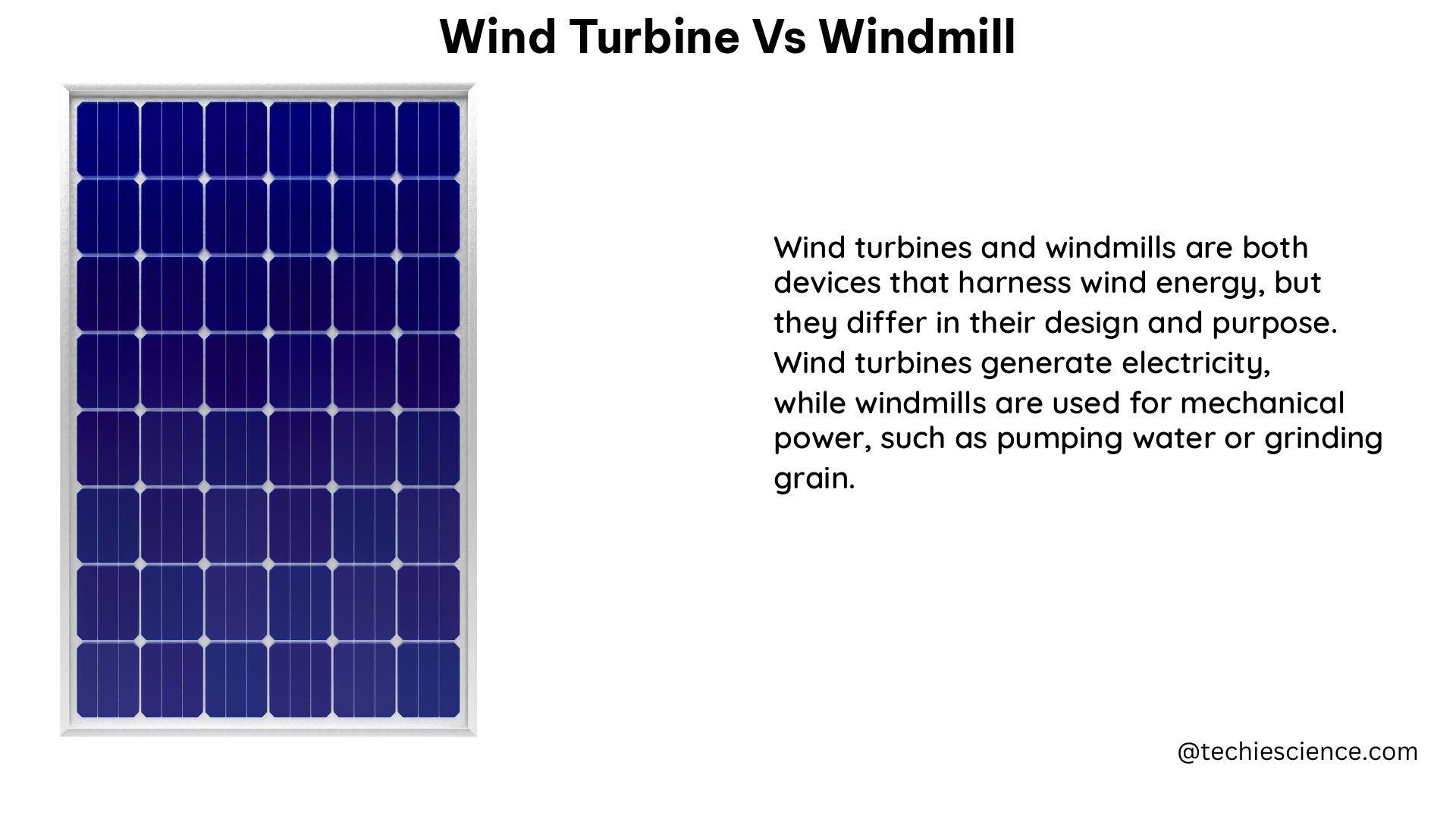Wind turbines and windmills are both devices that harness the power of the wind, but they have distinct functions and technical specifications. Understanding the differences between these two technologies is crucial for selecting the right solution for a specific application and optimizing its performance.
Wind Turbines: Electricity Generation
Wind turbines are designed to convert the kinetic energy of the wind into electrical energy. They typically have a power coefficient (Cp) of up to 0.59, which is the ratio of the actual power extracted by the turbine to the theoretical maximum power available in the wind. This high power coefficient is achieved through the use of advanced aerodynamic designs and sophisticated control systems.
Rotor Diameter and Hub Height
The rotor diameter of wind turbines typically ranges from 20 meters to 120 meters, with larger turbines generating more power. The hub height, which is the distance from the ground to the center of the rotor, ranges from 30 meters to 100 meters. Taller turbines can access stronger and more consistent winds, which can significantly improve their energy output.
Wind Speed Characteristics
Wind turbines have a cut-in wind speed ranging from 3 to 5 meters per second (m/s), which is the minimum wind speed required for the turbine to start generating power. The rated wind speed, which is the wind speed at which the turbine generates its maximum rated power, ranges from 12 to 17 m/s. Additionally, wind turbines have a cut-out wind speed ranging from 20 to 25 m/s, which is the maximum wind speed at which the turbine can safely operate before it shuts down to prevent damage.
Capacity Factor
The capacity factor of wind turbines, which is the ratio of the actual energy produced by the turbine to its maximum theoretical energy production, typically ranges from 20% to 40%. This relatively high capacity factor is a result of the advanced design and control systems employed in modern wind turbines.
Windmills: Mechanical Work

Windmills, on the other hand, are designed to convert the energy of the wind into rotational energy, which can be used to perform mechanical work such as grinding grain or pumping water. Windmills have a lower power coefficient (Cp) of up to 0.35, which is lower than that of wind turbines due to their simpler design and lower rotational speeds.
Rotor Diameter and Hub Height
The rotor diameter of windmills typically ranges from 2 to 10 meters, with smaller windmills used for pumping water and larger windmills used for grinding grain. The hub height of windmills ranges from 5 to 15 meters, with taller windmills able to access stronger and more consistent winds.
Wind Speed Characteristics
Windmills have a cut-in wind speed ranging from 2 to 4 m/s, which is similar to that of wind turbines. However, unlike wind turbines, windmills do not have a rated wind speed or a cut-out wind speed, as they are designed to operate continuously as long as there is wind.
Capacity Factor
The capacity factor of windmills typically ranges from 10% to 30%, which is lower than that of wind turbines due to their simpler design and lower rotational speeds.
DIY Wind Turbines: Customizable Renewable Energy
DIY wind turbines offer a cost-effective and customizable solution for generating renewable energy. These turbines can be built using various materials such as PVC pipes, bicycle wheels, and magnets, and they have a wide range of power outputs, from 10 watts to 1000 watts, depending on the size and design of the turbine.
Rotor Diameter and Hub Height
The rotor diameter of DIY wind turbines ranges from 0.5 meters to 3 meters, with larger turbines generating more power. The hub height of these turbines ranges from 2 meters to 10 meters, with taller turbines able to access stronger and more consistent winds.
Wind Speed Characteristics
DIY wind turbines have a cut-in wind speed ranging from 2 to 5 m/s, which is similar to that of commercial wind turbines. However, they do not have a rated wind speed or a cut-out wind speed, as they are designed to operate continuously as long as there is wind.
Capacity Factor
The capacity factor of DIY wind turbines ranges from 5% to 20%, which is lower than that of commercial wind turbines due to their smaller size and simpler design.
Conclusion
While wind turbines and windmills both harness the power of the wind, they have different applications and technical specifications. Wind turbines are designed to generate electricity, while windmills are designed to perform mechanical work. DIY wind turbines offer a cost-effective and customizable solution for generating renewable energy, but they have lower capacity factors and power coefficients compared to commercial wind turbines. Understanding these differences is crucial for selecting the right technology for a specific application and optimizing its performance.
References:
– National Renewable Energy Laboratory (NREL) – Wind Data and Tools
– Harvard Gazette – Large-scale wind power has its down side
– U.S. Department of Energy – Planning a Small Wind Electric System
– ScienceDirect – Wind Turbine
– Iowa Agriculture Literacy – Windmills vs. Wind Turbines

The lambdageeks.com Core SME Team is a group of experienced subject matter experts from diverse scientific and technical fields including Physics, Chemistry, Technology,Electronics & Electrical Engineering, Automotive, Mechanical Engineering. Our team collaborates to create high-quality, well-researched articles on a wide range of science and technology topics for the lambdageeks.com website.
All Our Senior SME are having more than 7 Years of experience in the respective fields . They are either Working Industry Professionals or assocaited With different Universities. Refer Our Authors Page to get to know About our Core SMEs.